Dateline – May 2022
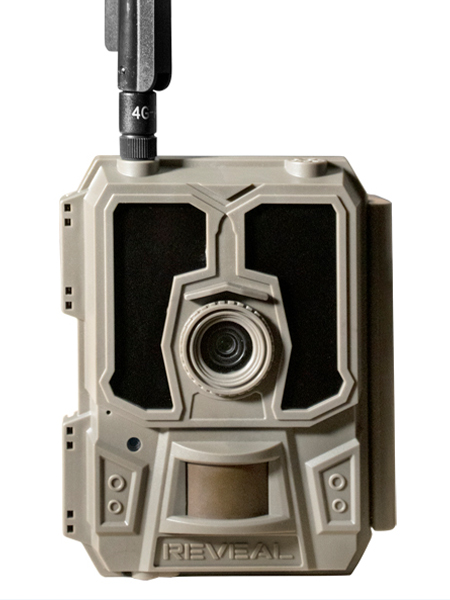
Launched in 2019
A couple of years ago I began to hear some positive buzz about a new and affordable cellular trail camera fresh on the market. Tactacam was an upstart company, and their new Reveal model—launched in 2019—seemed to be well received by most users. It was so well received, in fact, that copycat units were soon produced and rushed to market by many of the other major players in the trail camera arena. Reportedly, none these competing units quite measured up to Tactacam’s original offering.
In the time since the first Reveal model hit the shelves, Tactacam has developed and release a couple of updated versions in the form of the Reveal X, and then more recently, the Reveal XB.* I became curious about how well their latest models would perform. It has often been my experience with cellular trail cameras that a well executed early version will often be followed up with a less competent, and sometimes virtually unusable follow-on model. I’m not sure why this happens, but I have been bitten by this phenomenon more often than I’d like to admit.
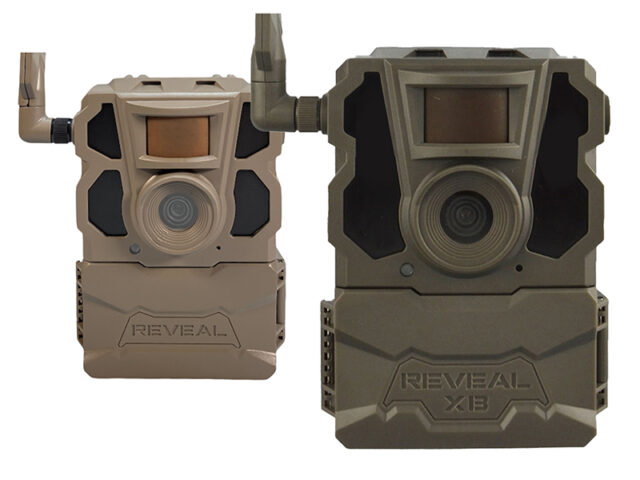
This article will review the Tactacam Reveal XB
Before we go any further, it is important to note that I use trail cameras in what can be considered an atypical manner. I do not ordinarily use trail cameras to keep tabs on game animals, but instead employ them in pursuit of an activity know as “camera trapping.” Typically, my main goal is to record unusual and hard to observe animals and their unique behaviors. The critters I pursue can be large or small, and as varied as reptiles, mammals, and birds. I’ve even recorded spawning carp on an occasion or two. Unquestionably atypical use, and as a consequence, I have a very specific set of criteria that I am looking for in a trail camera. Please keep that in mind while you read this review. My requirements may not overlap well with those seeking to use the camera to monitor game animal activity in a more conventional manner.

It’s also worth mentioning that there are a few basic things that any trail camera should be expected to do well. All trail cameras need to be able to detect the motion of an animal in their immediate field of view, and to respond fast enough to snap photographs while said animal is still in front of the camera. Trail cameras need to be durable and weatherproof. They need to facilitate mounting and securing. It’s in the implementation details where there is room for personal preference. I have a few things that I look for in trail cameras over and above their basic functionality. Here is my short list…
- The camera can be locked up securely with a padlock so that the SD card and settings cannot be tampered with
- Minimum number of nooks and crannies for spiders and bugs to nest in
- Settings available for good close up performance
- Option not to display logo chyron
- Tripod Mount—bottom preferred. A mount located on the back of the unit is better than nothing
- Long battery life
- Minimal false triggers
Concerning Technical Support… I never have high expectations for trail camera technical support—regardless of the brand. And I’m rarely in the mood for extended hold times just to get the technical support run around. Maybe I’m being a little cynical in this regard, but my philosophy has been that a trail camera does not need to be overly complex. If it is not relatively easy to configure and setup, and/or if there are technical difficulties that prevent its use, then the camera goes back in the box and is returned to the seller for a refund. I haven’t had to do this very often, but for these reasons I do not consider technical support in my reviews.
Finally, the Reveal XB and its support apps offer far too many features to cover them all in detail. Instead, I’m going to touch on the subset of features that are the most relevant to the way I use the camera—hopefully they will be important to you as well. Moreover, there are differences between the functionality provided by the web app vs the phone app version of the camera manager interface. For instance, In the web interface you can review the settings, but you cannot make changes… I’m not going to try to discover all of these differences. Just know that for any given feature, you make have to switch form the phone app to the web app—or vice versa—to access its functionality.
Ok, now that the disclaimers out of the way, let’s get on with the review…
I ordered my cameras through Amazon, and as expected they arrived in short order. Upon receipt, I was immediately impressed by the retail packaging. Corporate and brand identity were strongly and effectively communicated. I was doubly impressed by the camera after removing it from its retail box. The camera had the look and feel of high quality and good engineering. I quickly loaded my new Reveal XB with 12 Energizer Ultimate Lithium AA batteries and turned the unit on. Working through the setup instructions was a breeze, and soon I had the app installed on my phone, an online account, and my camera registered.
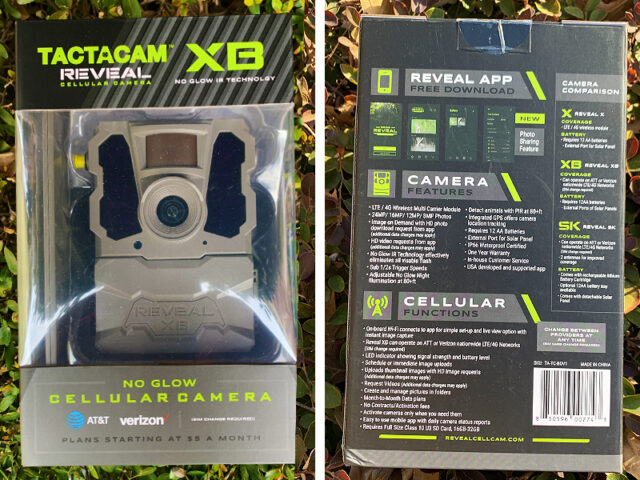
It was when I attempted to setup the camera for use in the field that I began to encounter a few stumbling blocks. Many of these, of course, can be fairly attributed to the learning curve. But others were due to inadequacies in the included Instruction Manual. A good example is the difficulty I experienced trying to access the Live View function and in-app SD card formatting. The instructions tell you that these features exist, they don’t explain how to find them in the app.
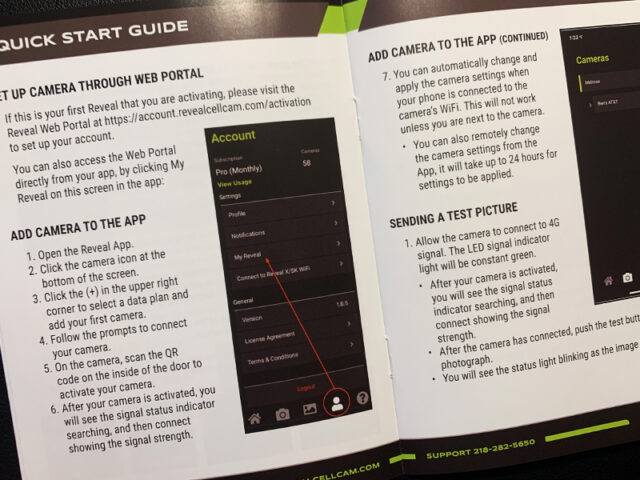
Live View, by the way, is a handy little features that allows you to use the phone app to view what the camera is seeing via a WIFI connection. Live View can be accessed when the camera is in setup mode, and in the field, it gives you the real-time ability to check the framing and level of the shots your camera will record. Framing trail camera pictures has always been a challenge. With Live View what once required guess work and trial and error, can now be accomplished with near 100% certainty.
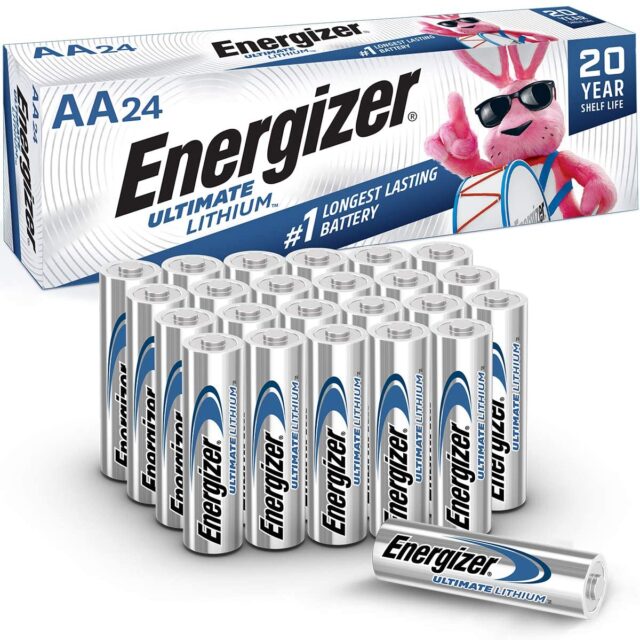
can last six months or longer in
a trail camera application
Eventually, and with the help of Google, I was able to configure the camera the way I wanted, and I installed it for a test run. Right away I noticed another concerning issue. According to the app interface, my brand new lithium batteries had dropped to 60% lifetime remaining in just a matter of minutes. It was not immediately clear if this was a fluke caused by bad batteries, or a real issue with the camera. Over time the reading went up to 70% lifetime, and then by the end of the second week of operation it was at 100%. A confusing set of readings to be sure, which did not do much to inspire confidence in this metric.
Nonetheless, after a few months of use I can report that the 100% reading has held steady, and battery life has proven to be excellent. This is something I am very happy about, as short battery life negates the benefit of having a cellular camera to a large degree. If you have to go out into the field regularly to change out batteries, you might as well save the extra expense of the cellular subscription and just retrieve your SD cards at the same time. Plus, batteries can be expensive—especially quality lithiums. Long battery life is essential for a good quality trail camera.
I’m also excited to report that false triggers have not been an issue either. False triggers are the bane of trail camera aficionados everywhere, and some cameras just do not manage this problem well. Fortunately, false triggers are not a problem with the Reveal XB. Fewer false triggers allows you to spend much less time actively managing the camera’s settings, and helps you to get the most bang for you buck from the cellular service plan you select. You’re paying for pictures of wildlife, not wind induced shadow movement. I’ll say it again, the Reveal XB very seldom false triggers.
Cellular service using the AT&T SIM card has also been excellent. Tactacam offers a number of different service plan levels, and all are competitively priced. In general, plans are structured so that you a pay little more depending on the number of pictures you expect your camera to upload on a monthly basis. A little guesswork is required when purchasing your first plan, but if you do happen to run out of plan credit, you can purchase more as needed to help you make it to the end of the month. Plans are offered at a slight discount if purchased at the annual rate.
So, now that we’ve discussed the good, let’s take a look at the not-so-good aspects of this trail camera. Some of the things we’ll touch on going forward can be considered major issues and others are just minor annoyances. For many of you, your own personal preferences will determine which are which.
The Tactacam Reveal XB strikes me as haven been designed by folks who had a set of very specific trail camera issues that they wanted to address. It seems as if they went to great lengths to correct their personal pet peeves, but then they whiffed to one degree or the other on other obvious and already solved issues. This means that they had a couple of designed points that were well thought out and effectively implemented, but unfortunately it appears that many other design and engineering decisions were made in a less thoughtful and deliberate way.

is offered as a selling point
for the Reveal XB.
I don’t agree that it is
The antenna may be the camera’s most concerning weak point. The way it is implemented appears to be a problem just waiting to occur. The fragile nature of the antenna and its connector mean that it may be subject to breaking if the unit is carried loose in a backpack or duffle. Depending on its positioning, the antenna can get in the way of opening the access panel. Worse yet, the antenna is vulnerable to loosening during onsite camera installation. Every time the antenna is repositioned there is the possibility that its connector may be loosened. If this happens the weatherproofing will be compromised, introducing an avenue for moisture to enter the unit. Water is never good for electronic devices, and at the very least this situation is likely to result in condensation on the lens cover. This will be a problem certain to be detrimental to your picture quality. I try to remember to check the tightness of the antenna connection before I leave each set, but I am sure it is only a matter of time before I forget and am bitten by this design flaw.
The Reveal XB’s picture quality is good, but not quite to the level I’d prefer. Images can contain blur and other imaging artifacts that should not be present on a good quality 24 megapixel image. The pictures produced by this unit are more than adequate for camera trapping, but you won’t be generating many high quality prints from your photos. And, unfortunately, there doesn’t appear to be a way to turn off the Tactacam logo chyron that is superimposed across the bottom of the pictures the camera records. The ability to turn off the info bar is included with most mid to high end trail cameras, and the Reveal XB really should offer this option as well.

Not too shabby

As I mentioned earlier, I often use trail cameras to record pictures of small animals. In this pursuit I sometimes place the camera very near where I expect the subject to be when the camera is triggered. Used in this manner the Tactacam Reveal XB has performed quite nicely, and I have been generally satisfied.

After dark, the LED flash has proven to be adequate in all of the contexts that I have tested it in. Nighttime images can be good if the subject is stationary, but the tiniest bit of movement will introduce motion blur. Regardless, the infrared images typically allow for the identification of the pictured animals, and that is really all that I require from photos taken during the darkness of night.

You are able to view Low-Res thumbnails of the photographs your camera uploads in the Tactacam app— either on your phone or on the web. You can request Hi-Res pictures for a small fee, but these pictures will not be the 24 megapixels (6000 x 4000) the camera’s specs promise. Instead they will be a much smaller 3 megapixel (1920 x 1440) images. These are better than the 0.3 megapixel (640 x 480) thumbnails provided free of charge in the app, but you will have to travel out to the field to retrieve your SD Card for the real full size images. And be forewarned, Tactacam provides no way for you to keep up with how much you are spending on Hi-Res images—a pretty serious shortcoming in my opinion.
Further, If the camera is set to take a series of photos at each triggering, Only one picture from each series will be uploaded to the app for viewing. So, if the Reveal XB is set to take 3 pictures, there is a 66% chance the image you are really interested in won’t be available online. If there is something very specific you are watching for, you might be left with only tantalizing hints as to what your camera has really recorded. Only a trip into the field to retrieve the SD card will allow you to be sure.
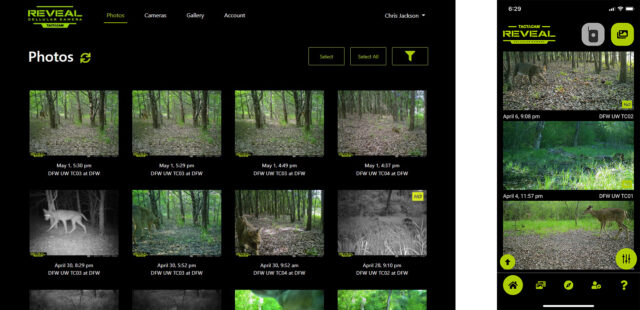
Click to Enlarge
The web interface for the video settings suggests that there are three video resolutions to choose from WVGA-LOW, 720p-MED, and 1080P-HI. In practice this was not the case—there was only WVGA and 720P. In addition, the forced video/picture combination option was a disappointment. In this mode, pictures are taken first and then the video is recorded. Many times what would have been the best part of the video was missed while the camera snapped stills. Unfortunately, there is no option for video alone, though turning off Multi Shot may help with this issue to a degree.
For my purposes the video quality produced by this camera was not adequate. Videos often showed compression artifacts—resulting in loss of important detail—especially if the subject was in motion. If you really care about getting good quality videos, this is probably not the camera you are looking for.
As with so many other aspects of this camera, its supporting apps (web and phone) are good but not great. The app interface is not consistent between the web app and the phone app. You cannot adjust the camera’s settings on the web app, for instance. Some features can be difficult to locate in the apps. And there does not appear to be a way to request hi-res images while reviewing pictures individually in the phone app or the web app.
Now let’s take a look at the final ratings taking all of the above into consideration…
- Recommend – I would recommend this camera. Maybe not the strongest recommendation, but I would recommend nonetheless. SCORE: FULL STAR
- Buy Again – I own four of these cameras now, and would consider buying more if needed. SCORE: FULL STAR
- Picture quality – Picture quality is not exceptional, but more than adequate. SCORE: FULL STAR
- Video quality – Video quality was disappointing, with compression artifacts detracting from what otherwise would have been compelling footage. Mandatory video/picture combo not preferred. SCORE: NO STAR
- False triggers – False triggers are few and far between. SCORE: FULL STAR
- Battery Life – Battery life has been exceptional. SCORE: FULL STAR
- Affordable – At $150 these units are priced slightly on the high side of just right. Cellular service plan pricing is competitive SCORE: FULL STAR
- Cellular Reception – Cellular reception has not been an issue. SCORE: FULL STAR
- Phone and Web Apps – Both apps could be better, but despite their shortcomings, they get the job done. SCORE: HALF STAR
- Special Considerations – The antenna has the potential to be a real problem. In most other ways the camera does a fairly good job addressing my personal preferences. SCORE: HALF STAR
RATING: Eight out of Ten Stars

The Tactacam Reveal XB is a good but not great trail camera. But even though I’m on the lookout for the perfect cellular trail camera, for the time being, the Tactacam Reveal XB suits me just fine. I paid right around $150 a piece for my Reveal XBs. I’ve purchased cellular cameras that cost twice as much, and I’ve bought units that cost half as much. None have been perfect. Some have been pretty good. Others have been complete disasters. The Reveal XB comes with its own set of unique pros and cons, and as such is as good or better than any cellular trail camera I’ve owned to date.
Update – January 22, 2023
Well, after using these camera for just around a year, I finally had the antenna mishap that I anticipated. One of my Reveal XBs attracted the attention of a young buck, and through his investigation he managed to pop the antenna off of the camera. The threaded attachment gave way and the entire antenna was dislodged, leaving the antenna port fully exposed.
There are a few things that seem to be of note in retrospect. First, the antenna came off with very little encouragement from the deer—I can only imagine what a determined Raccoon would be able to do. Second, the camera continued to function flawlessly, even without the external antenna. Pictures still recorded (as expected) and uploaded (somewhat surprisingly) for weeks after the incident. In fact, I had no idea that the unit had been damaged until I visited the site in person to service the camera. Finally, it appears my fear of moisture entering through the antenna jack was unfounded. The camera endured several severe weather events without the antenna present, and was no worse for the wear.
So, now the question becomes, is the external antenna even necessary or is it simply ornamental? I’m not well versed in the technical aspects of antenna technology, so I cannot say for sure one way or the other. Perhaps a knowledgeable reader will chime in with some important technical insight. In the meanwhile, it remains clear that the antenna is the weak link on an otherwise fine trail camera. Tactacam seems to recognize this, and offers replacement antennas for sale on their corporate website. Hopefully, Tactacam will see fit to rectify this issue in future models.
Footnotes
*Tactacam also offers a Reveal SK model which is just the Reveal XB outfitted with two antennas, rechargeable batteries, and a solar panel.


Do not purchase Tactacam. I have perfectly work camera that I bought 3 years ago. They changed their firmware and now it’s useless. I suspect numerous other people have been effected. Customer service said send it to them and for $20.99 plus me pay shipping and handling they’d see if they could update firmware but no guarantee they could. Tried to sell me new camera. Stay away from this company.
Mine worked great…for about 3 months. Then was only sending 1 out of 5 pictures. Now it wont even pick up my dog less than 20ft away. Called customer service, did everything they said. Still only works occasionally. Going back to browning.
Be wary of XB and SK. XB has issues like my SK. The solar panel that comes with it doesn’t keep batteries charged.
My date, time and year has been wrong. I performed one update to temporarily fix the issue. The problem reoccurred. Customer Support was great in helping me update the firmware for a second time. I hope the issue is resolved. My camera has been home too much. It needs to be in the woods scouting for me.
I have been using trail cams for about 20 years now and have owned probably 50 different cams. I have 2 Tactacams and they are hands down the best value for your dollar in cellular cams. I keep my cams running year round and have had no problems whatsoever. You definitely can request individual hi-res pics on the app. You just simply hold down on the pic til it turns green then select the hi res pic. There’s always gonna be haters, but for the everyday hunter, these are the absolute best cams for the price on the market. Most people who have problems just don’t know how to follow directions. I’ve had TONS of squirrels and deer messing with my cams and never had an antenna issue either
The Virginia Opossum is a marsupial, not a mammal They also rarely get rabies bc their body temp is too cold for them to be infected and they are amazing natural garbage disposals… Sweet lil guys, if only people would take the time to learn about them instead of immediately hating them.. (and not in any way saying that was inferred in this article at all!! Just saw the pic and wanted to holler from my soapbox for a minute)
EDITOR’S NOTE: Opossums are indeed marsupials… and they are also mammals. Marsupials are a type of mammal.